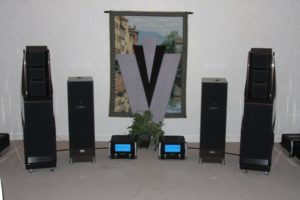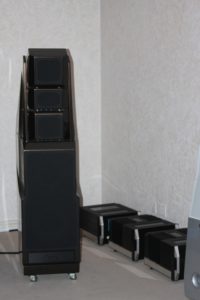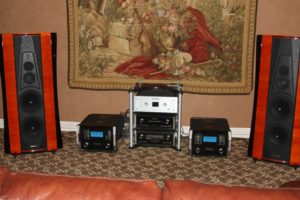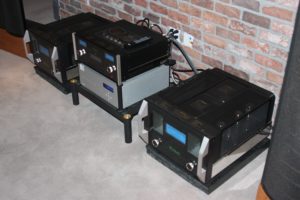Hi Fi Listening Room
I recently attended a meeting of a local hi-fi club. The club has about 30 people attending on the average and they meet at a church or sometimes a local dealer. This week they were meeting at a local dealer who carried numerous hi end equipment lines. I have heard some of this higher end technology at trade shows. As we all know, trade shows with their converted hotel rooms, are not acoustic optimized. They are not even optimized for normal speech intelligibility, let alone musical energy. This dealer location meeting provided a chance to listen to this gear in a room dedicated to listening to music.
Good Room Size
The room was a good size. I estimated about 25’W x 12’H x 40’L. Great room dimensions, especially the 40′ length. The front wall was an exterior wall of a brick building. On the front wall, there was a tapestry about 4′ long hanging at center stage. In front of the tapestry, there was a structure shaped like the letter V, with multiple colors of fabric. In front of the tapestry was a plant. The tapestry and letter V had to be sound absorption technologies and I am guessing the plant represented sound diffusion. All joking aside, all of this had to be about appearance more than function. There was no real acoustic advantage to any of these items. There was not enough of any technology to have any acoustical impact.
Rear Wall
The rear wall had an equipment rack about 6′ tall at the rear center of the back of the room. It was about 12″ out into the room from the rear wall. I am sure this was to facilitate equipment and wire changes. The letter V wall hanging symbol appeared on the rear wall center and at the side wall center about 20′ into the room.
Side Walls Same
The right and left side walls were identical in configuration, with speaker, amplifiers, and side wall to speaker distances. Both side walls were interior walls. There were power amplifiers were placed along the intersection between the floor and side wall. I do not believe these amplifiers were functioning. There was no room treatment at the primary reflection point off of the side wall on either side. There was also no room treatment for secondary and tertiary reflections at the listening position. The listening position(s) were about 30 chairs positioned back third of the room. I am hopeful that there is only one chair for actual demonstration purposes and that this seating arrangement was for the 30 club members.
Low Frequency Drivers
The speakers had a time aligned mid section with low frequency drivers in the cabinet bottom. They were at least 12″ diameter drivers with one, maybe two drivers in each cabinet bottom. Alongside each speaker was a sub woofer which was taller than most subs I have seen in the hi-fi market. I will guess at least two drivers per sub woofer cabinet. Adding all of these low frequency drivers together, we had 4 per channel to represent 8 drivers at least 12″ in diameter and maybe even larger inside a room with a volume of 12,000 cu.ft.
Sound Stage
The sound stage was large and the mid range was balanced across the sound stage. It was a sound stage that had width along with height, with good definition and separation. The low end was overwhelming the middle range when both low frequency drivers and mid range drivers were playing at the same time. There was simply too much low frequency generated energy trying to find its place in the 12,000 cu. ft. We also had an axial mode somewhere in the 30 Hz. – 35 Hz. range. It was a big one, more towards the room front. You know the kind that starts small and blooms as it energizes itself within its own fundamental and harmonics. By trying to fit into the undesirable room dimension that is its creator. It is smothering everything in its struggle. All other low frequencies were present and accounted for.
Specification Discussion
The discussion from most in the room was of the technical qualities of the speakers. They each weighed 750 pounds and were formed out of resins. Machine and finish work were well done. Technology updates to the speakers were also available and one could update a speaker as the designer improved upon the speaker components over time. There was little discussion of the sound of each speaker and there was no discussion of the sound in the room. These two areas especially the room sound needed to be addressed.
Emotional Connection
Did this system bring about an emotional connection to the music? That is the true test of a room and system. There is no need to rely on an acoustic memory that in humans is so short lived that doing an A/B comparison with any amount of time in between A and B, exponentially increases the error or sonic opinion rate of the sample. How did you feel when you heard both A and B ? Its easier to remember the feeling than trying to mentally record A and hold it that acoustic memory of A until after you hear B. The feeling contains all the data, trust that metric.
Middle Range Quality
The presentation was visceral and vocals shined. The mid range was wonderful and clear except for the side wall reflections. Reflections in this horizontal plane across the sound stage domain are very confusing and will cover up nuances that the designer painstakingly put into this price point of product. The sounds are there within the technology but the room and the associated reflections are covering some of them. The side walls needed absorption or diffusion technology to reduce the time signature of the reflection well below the wanted direct energy from the speakers. I know the engineer who designed these speakers would welcome it. That, I have no doubt.
Less Energy – More Definition
Low frequency energy from 8 drivers is not necessary, not in a room of 12,000 cu. ft. Four low drivers would have been more than enough. In fact, it would have been good to shut off the subs and just listen to the drivers inside each right and left channel speaker. That reduced energy into the room may have been enough of a pressure reduction to rid the room of its 30 Hz.-35 Hz. front of the room resonance. It was very present and very annoying.
Equipment And Room Disappear
A sound system is about bringing us closer to the music. Closer, so we can make an emotional connection to the music. We need to forget that we are in a box listening to boxes. The speakers and room should acoustically disappear. The room and the system must work together to accomplish this disappearing act. It is a symbiotic relationship. Neither gear or room treatment can stand alone and provide us with an emotional cable that we can plug into. Don’t be concerned with appearance and price, be concerned with how the system made you feel. The room sound and the gear sound are only the physical means to this spiritual end.









